What about a trip into the Sperrgebiet? With all the luck I had so far (not really, but the relative lack of bad luck makes me quite lucky), it’s not unreasonable to allow myself to believe that I can bump into a diamond, sell it, and take holidays after my cycling trip.
Il Sperrgebiet, “prohibited area”, is a piece of land (26000 km²) almost as big as Belgium that is reserved for mining diamonds. It covers about 320 km of coastline, and extends about 100 km inland. It’s forbidden to enter this area, with a few exceptions: the town of Lüderitz, on the coast, and the road leading to it.
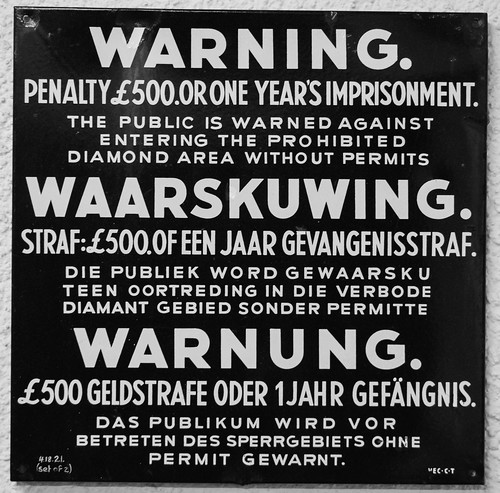
Nonostante il pezzo di telaio rotto e la riparazione che ho dovuto affrontare due giorni fa, sono ancora troppo curioso per evitare Lüderitz. Se voglio essere sicuro di arrivare a Città del Capo con la mia attrezzatura appena riparata, dovrei andare a sud ora ed evitare i 120 km extra fino a Lüderitz e tornare sulla stessa strada. Se guardi la mappa, avresti davvero bisogno di una buona ragione per andare in quel cul-de-sac. Ma solo perché nessuno ci andrebbe, e perché si trova nell'area proibita, e anche perché la strada è asfaltata per la mia debole portapacchi posteriore, questi sono motivi sufficienti per farmi andare.
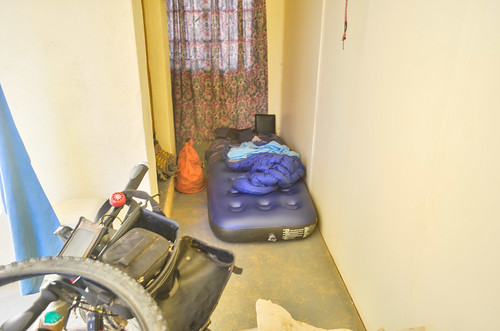
La mia notte in Aus è stata gelida, anche se ho deciso di non dormire all'aperto. Dopo una doccia calda per riprendermi dal letargo, sono pronto a partire, anche se abbastanza in ritardo.
C'è molto vento, e nella direzione giusta! Inoltre, Aus si trova a 1500 m di altitudine, il che significa che ho una discesa di 1500 m favorendo il vento a favore fino alla costa. Quindi questi 120 km sono il mio obiettivo per la giornata.
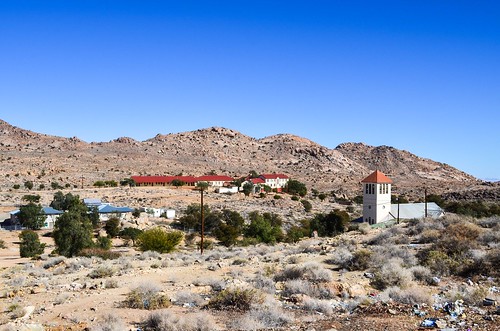
Se ho discesa + vento a favore per affrontare questi 120 KM, come farò a risalire? E siccome è quasi mezzogiorno, non è nemmeno garantito che arrivi a Lüderitz oggi. Dato che oggi pedalerò attraverso lo Sperrgebiet, non mi aspetto di trovare alcun rifugio, quindi il mio piano è il seguente: 1- pedalare il più velocemente possibile verso Lüderitz e limitare le pause fotografiche. 2- riposare qualche giorno a Lüderitz, dato che non l'ho fatto da Windhoek. 3- risalire ad Aus in due giorni, visitando la città fantasma mineraria e i cavalli selvaggi lungo il percorso, e dormendo nel posto meno impraticabile che avrò notato in discesa.

I complete my first 20 kilometers without moving my legs. It’s not a joke, that tailwind is magic. I try not to count how many hours it will take me to go back if that wind remains the same, and enjoy the desert scenery scrolling by me at a fast speed.

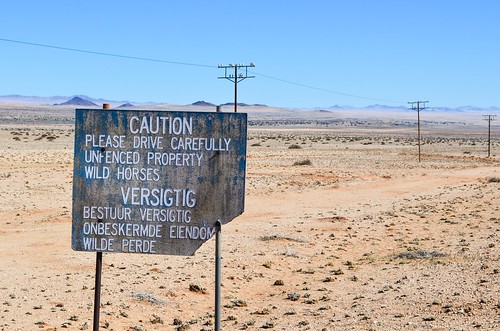
I quickly reach Garub, a place name without any living human, known for its wild horses, but I continue straight. It will make a nice break from the headwind on my way back, just before the long ascent.

Allora, perché lo Sperrgebiet è così grande? L'attività mineraria avviene solo nel 5% dell'area di terra vietata, lungo la costa. Ai tempi deiAfrica tedesca del Sud-Ovesti tedeschi dichiararono quest'area Sperrgebiet nel 1908, a seguito della scoperta dei diamanti. I tedeschi erano lì in primo luogo perché rappresentava il loro punto di ingresso nella colonizzazione dell'attuale Namibia. Fondarono la città di Lüderitz ancor prima di Swakopmund. E mentre costruivano una ferrovia attraverso il deserto per arrivare all'interno del paese, si imbatterono in questi diamanti.
Per assicurarsi che nessun altro si avvicinasse troppo, fissarono il confine orientale dello Sperrgebiet a cento chilometri nell'entroterra. Nei primi anni del 1900, quella distanza e l'ambiente completamente inospitale erano sufficienti a scoraggiare chiunque dal viaggiare verso i diamanti.
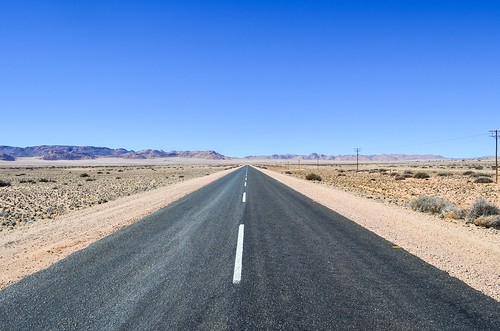
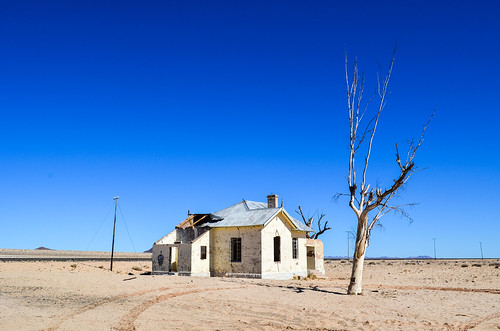
Mentre pedalo veloce, cerco di individuare tutti i tipi di ripari dal vento per campeggiare al mio ritorno. Dovrebbe essere il più vicino possibile al punto di metà strada. La stazione ferroviaria di Garub ha quattro muri in piedi, quindi costituisce un riparo perfetto, ma è ancora troppo presto. A parte le strutture costruite dall'uomo, non riesco a immaginare dove potrei trovare altro per proteggermi dal vento. È un deserto bellissimo tutto intorno alla strada.


La fatiscente stazione ferroviaria di Garub è una delle stazioni della linea Aus-Lüderitz, apparentemente costruita in soli 9 mesi dai tedeschi all'inizio del 1900. I filotedeschi useranno questo fatto storico per sostenere che l'Africa può funzionare molto bene se le persone giuste sono al comando, altri evidenzieranno che all'epoca non esistevano regolamentazioni sul lavoro e si sfruttava il lavoro gratuito delle tribù locali schiavizzate. Sono ormai anni che il governo cerca di riabilitarla.
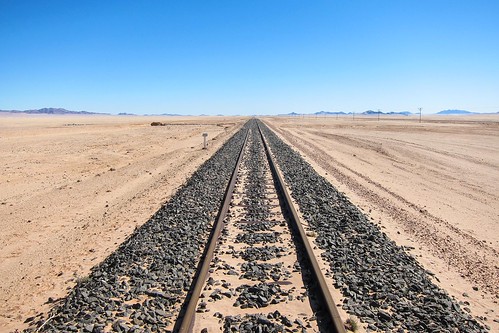

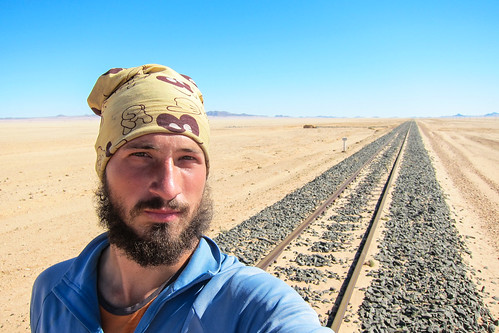
Oggi, il Sperrgebiet è controllato da Namdeb, una holding, non sorprendentemente posseduta per il 50% da De Beers, the diamond mafia (directed by the former head of Alstom Transport), the other 50% belonging to the Namibian state. The composition is 40% desert, 30 % grassland, 28% rocky, but it all look desert to me. Because the entry is forbidden, I was told that if I am seen away from the only road, I will be spotted by satellites and picked up by a helicopter. I’m sure a lot of it is folklore, since a wannabe diamond digger would need a lot of equipment and time to make the smallest discovery there, butscary high-security stories are plentiful. I also heard that people used to hand pick diamonds on the beach. If it was still possible and open to anyone, a diamond wouldn’t be “forever” and the whole La strategia pubblicitaria di De Beers non funzionerebbe così bene. Lo Sperrgebiet è stato designato come parco nazionale nel giugno 2004, ma sembra che De Beers stia rallentando il governo della Namibia nell'aprire l'area ai turisti. A sud, la strada per Oranjemund, una 'città De Beers', è ora aperta ai non minatori, ma è consentito loro solo un tempo limitato per percorrere la distanza tra i due cancelli, come se qualcuno volesse assicurarsi che non escano dalla strada e non si imbattano per caso in un diamante …

Non andavo così veloce da secoli, forse dai tempi dell’asfalto in Ovamboland, qualche mese fa. Alle 14:00 avevo già percorso 70 km in bicicletta (partendo alle 10:30). Avevo dimenticato quanto le strade asfaltate rendano le cose molto più veloci rispetto alle strade sterrate. Il sole mi sta bruciando non poco, ma sto comunque godendo il viaggio. Con questa velocità, riuscirò ad arrivare a Lüderitz per il tramonto sul molo.
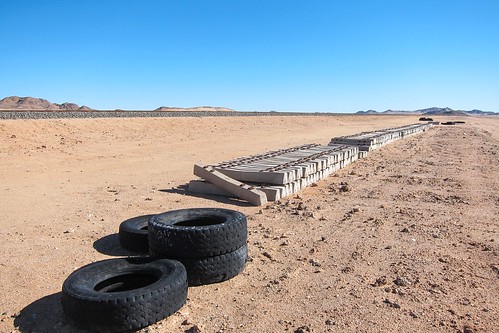
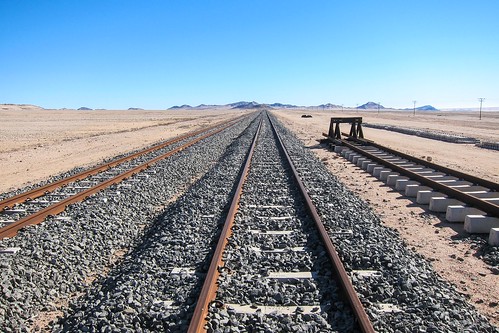
Mi è stato detto che i lavori di riabilitazione della ferrovia sono stati abbandonati da qualche parte nel deserto, potrebbe essere qui.
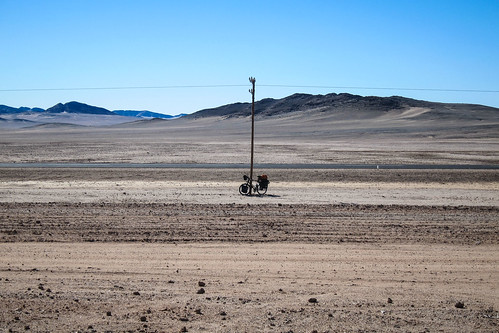
Qualche chilometro più avanti, passo un’altra stazione in rovina, chiamata Haalenberg.

I pay a visit to the dilapidated building, that would make a perfect shelter on my way back, 50 km from Lüderitz, 70 km from Aus. And there is a human here! He is watching the workers camp during the weekend. He says a crew of 10 is working here on weekdays, sleeping in tents, working on the railway. So it is not abandoned! And because they are here, not really with comfort, but at least with a diesel generator and water tanks, I can use Haalenberg also as a water-refill station! Perfect. I say goodbye and see you later, and continue onto Lüderitz.
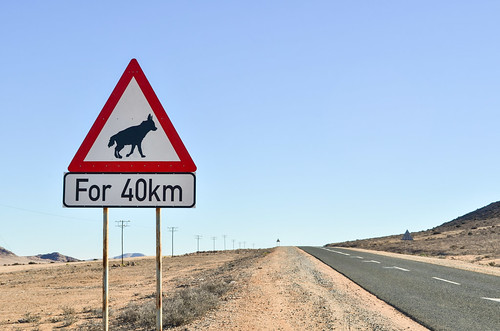
This signs warns against hyenas until Lüderitz. I have 40 km and 2 hours of daylight left, so it will work fine until Lüderitz. Or so I thought. Because that small hill will change everything …
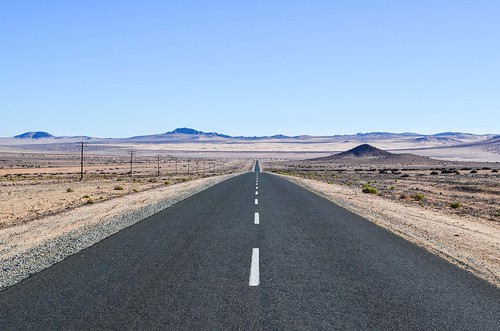
Just after that hill, the wind starts blowing from the south. Still a very strong wind. And that’s terrible! I now have to cycle even downhill. And I have a ridiculous speed on the flat. I zoom on my GPS to check the road: from now on, it is zigzagging like a broken line between the dunes until the West coast of Africa. It means I am getting the wind slightly on my face, or slightly in my back, depending on the direction. Despite the shallow impact angles, the wind is strong enough to stop me or to push me.

Se stessi guardando un film della sabbia che soffia sull'asfalto, come onde, sarebbe sicuramente bello. Ma viverlo è una storia completamente diversa. Non posso goderne. Le mie gambe sono esauste e un buon sforzo mi porta solo a poche centinaia di metri di distanza. In questo tipo di paesaggio, se faccio marcia indietro, sembra davvero che non mi sia mosso affatto. Quell'ultimo tratto di strada è abbastanza sabbioso, mentre all'inizio era più roccioso. Durante le raffiche, la sabbia mi soffia in faccia… sì, sto subendo una sabbiatura. Stanotte avrò la pelle molto liscia, ma questo non migliora il mio umore.

It’s still 30 km to the end. At that moment, I abandon the idea of reaching Lüderitz. I check closer the first two buildings I encounter, which are actually just large blocks for a pumping station. I can barely hide behind. The desert was so nice and beautiful an hour ago, and it now qualifies for the “hell on Earth” category. Maybe I can sleep at another train station in ruins, 20 KM from the end? Or at the airport, some 10 KM from the end. I’ve heard about a cyclist stranded in a sand storm who had to ask for shelter at that airport.
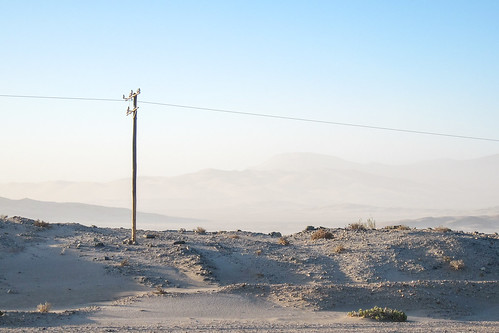
Con tutta la sabbia che vola in giro, non c'è modo che io possa tirare fuori la mia dSLR dalla borsa. Cerco di catturare le condizioni davvero pessime con la mia fotocamera compatta, ma non funziona. E voglio davvero dormire al chiuso stanotte. Avevo in mente di raggiungere Lüderitz e riposare qualche giorno in un posto confortevole, con muri e un letto solo per me, ed è davvero straziante considerare ora di campeggiare tra le rovine. Ho bisogno di qualche giorno pigro, e può iniziare domani solo se stasera arrivo in città.

Passando davanti alla stazione di Grasplatz al tramonto, decido che voglio la mia notte confortevole, e arriverò a Lüderitz, indipendentemente dalla sabbia, dal vento, dalle iene o qualsiasi altra cosa si frapponga sul mio cammino. Mancano 20 KM, quindi un minimo di 2 ore di pedalata al crepuscolo e di notte. Gli zigzag rendono facile contare la distanza: più o meno 4 km di vento in faccia, 3,5 km di vento a favore, 3 km di vento in faccia, 2,5 km di vento a favore, 2 km di vento in faccia ...
Il sole scompare proprio quando passo vicino all'aeroporto. Aeroporto qui significa una pista di terra, un hangar e due edifici che non sembrano frequentati. Oh, il foto satellitare shows a tarred runway, so maybe they clean the sand before the landing of an airplane. I also pass the Kolmanskop ghost town, which I will visit on my way back. There is a small ascent afterwards, which takes me ages to climb with the headwind. At that time, despite the quasi-nonexistent traffic of this road, there is a bus of mine workers stuck behind me. They are most likely coming from the Elizabeth Bay mine, behind Kolmanskop. For a very long minute, the bus drives at my speed, I’d say 8 km/h, behind my wheels, until the next turn into the “tailwind direction”. The miners cheer at me while it overtakes.
The very last kilometers bring me at night to the first lights of the town, and I can finally contemplate civilization and comfort. Arriving at night in a new place and seeing the first lights is another special moment! My chain is making clunking noises, it sounds painful, as to echo my face trying to break into the headwind. I guess the flying sand managed to make a way through the chainglider.
And I’m finally in town! I made it! I was warned that cycling from Aus to Lüderitz would be painful, but I didn’t imagine what it would feel to be facing a combo headwind/sandstorm in the desert. It’s indeed painful.
La città è deserta, come una piccola città di domenica sera, ma il benzinaio mi indica i backpackers. Non vedo l'ora di fare una doccia e sdraiarmi a letto. Le gambe sono morte e il viso sembra sabbioso. In realtà faceva fisicamente male quando la sabbia mi sferzava il collo.
Una volta lì… il backpackers non ha luci accese. Le porte sono chiuse. Noooo… sarebbe proprio troppo ingiusto! Non avevo controllato la disponibilità e mi ero affidato a persone che me ne avevano parlato qualche giorno fa. Bene, chiamiamo quel numero stampato sulla porta.
It appears that the owners are away, so the neighbors are taking care of it for the night. And since there are only two guests, including me, we are invited for dinner at Doris and Ian’s. Food, wine, beers, and unique stories about diamonds from the former manager of the port of Lüderitz. It couldn’t have ended better! Especially considering I had seen myself camping 20 KM away, in the wind, in the sand, behind a wall of ruins. And it’s another day as emotionally heavy as a whole month of “normal life”. Tomorrow I will have to toothbrush-clean my chain very well, but also to raid the supermarket!
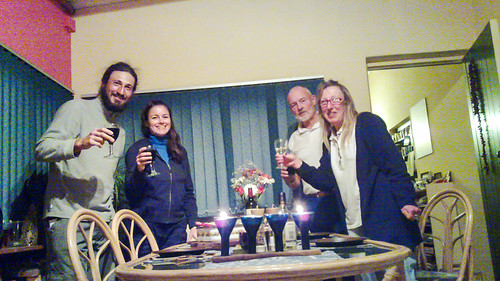
The town of Lüderitz was founded in 1883, even if the bay of Angra Pequenahad been “discovered” four centuries earlier by Bartolomeu Dias, a Portuguese explorer slightly contemporary of Diogo Cão, who erected a padrão cross at Cape Cross, where I saw the fur seal colony. Lüderitz is the first foot of Germany into Africa tedesca del Sud-Ovest, starting in 1883 when Adolf Lüderitz, a merchant from Bremen, purchased an immense plot of land, as large as the Sperrgebiet, to a local Nama chief, with money and rifles. Lüderitz then transferred his rights to the German government of Bismarck.

Finalmente 'fuori servizio', posso passeggiare per la città e cercare di capire perché sono venuto fino qui. Ha un'atmosfera molto rilassata, senza sembrare una località balneare.




Il Linea Woermann era una compagnia di navigazione di Amburgo, successivamente integrata nel colosso odierno Hapag-Lloyd, parte del gruppo TUI. Avevo visto una mappa delle loro rotteal museo di Tsumeb. All'epoca era la principale linea di trasporto tra Germania e Namibia. Oggi è possibile trovare Woermann quasi ovunque in Namibia, tramite i supermercati Woermann & Brock uno dei più grandi gruppi commerciali del paese.


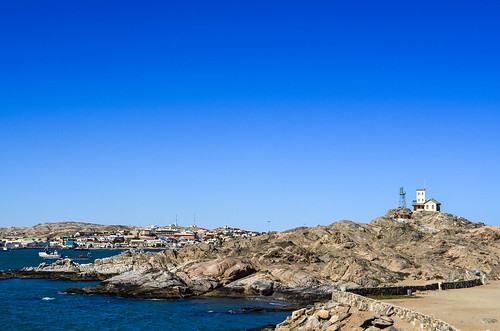

Passando davanti al faro, ora mi trovo su Isola degli squali(Isola Haifisch), il che è un po' un nonsenso vergognoso di per sé. Non geograficamente (era un'isola fino al 1906, prima di essere collegata alla città), ma storicamente: se oggi è un campeggio per turisti, ed è troppo ventoso per i turisti che devono campeggiare fuori dalla loro auto, è stato un campo di concentramento for 3 years, between 1904 and 1907. It is believed that 2000 prisoners lived on that tiny island, and were used to build the railway and the port. Half of them died due to the poor living conditions. Numbers from Wikipedia are much higher. Germany has recently recognized the killings of the Nama and Herero people as a genocide.

So, in short, the Nama people, which form the largest group of the Khoikhoi people, the original nomadic inhabitants of Southern Africa before the Bantus migrated south, have been, alongside with the Herero people, ridusse al 20% – 50% della loro popolazione iniziale, e l'isola degli squali giocò un ruolo importante in quello sterminio. Eppure, qual è la più grande pietra commemorativa di Shark Island? Un memoriale per una nave affondata nella baia. L'isola rimane sicuramente uno strano campeggio.
Passato il campeggio, cammino per le stradine di Lüderitz. Preferisco quell'esperienza a Swakopmund, la città più turistica della Namibia che mette in risalto la sua architettura tedesca. A me sembrava più Disneyland, mentre Lüderitz ha edifici intatti che non sono stati trasformati in uno Shoprite.
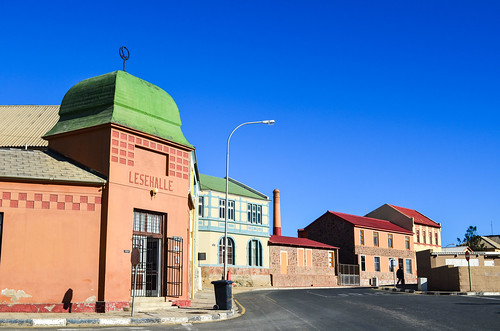

Proprio sopra la chiesa è eretta la Goerke Haus, the poshest house of the town, also with the best views on Lüderitz. It was first built in 1910 as the residence of a lieutenant of the German Schutztruppe, and then belonged to Consolidated Diamond Mines of SWA (De Beers already), to be finally abandoned. It has been restored by Namdeb (still De Beers) and is now used to host Namdeb diamond people. But when it’s not hosting, the house is open to the public, and I could see how were the German living in the middle of the desert a hundred years ago:
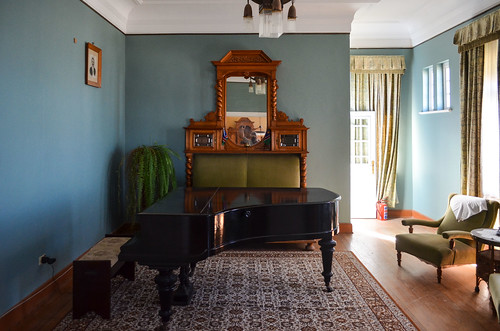
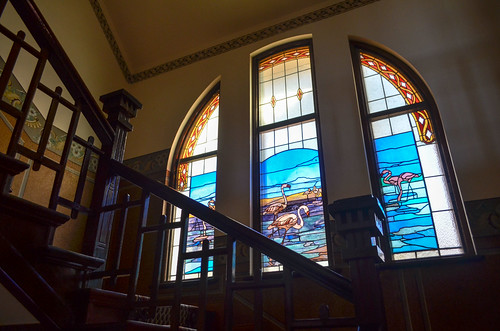
The views from the top window of the Goerke Haus are unbeatable.




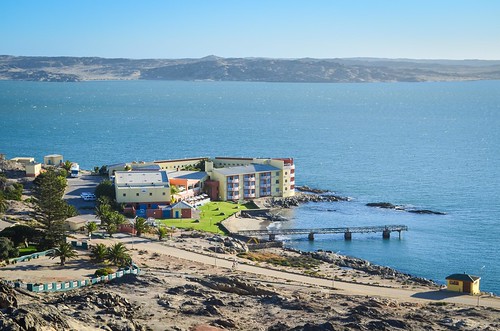


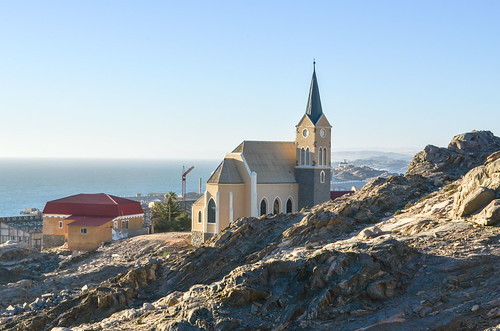
La giornata si conclude con un drink al porto con Céline, uno squisito springbok cucinato da Doris e un libro sul Sperrgebiet preso in prestito da Ian. Un libro sui segreti dell'area diamantifera vietata, perfetto per il mio prossimo 'tour di esplorazione dei diamanti'!






Piacevole da seguire e davvero interessante. Fa venire voglia di andarci nonostante le iene!
Cose fantastiche! Non vedo l'ora del prossimo, JB 🙂
È lì che si stabilisce il record di velocità con il kitesurf e la vela!
Ben visto, è nella laguna accanto. Ho troppe foto per un solo post quindi è programmato per il prossimo. Non ero nella stagione giusta per la sfida di velocità (né per il bagno), ci sei stato tu?